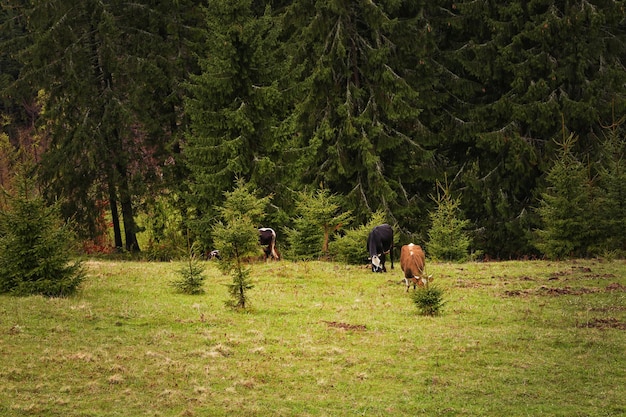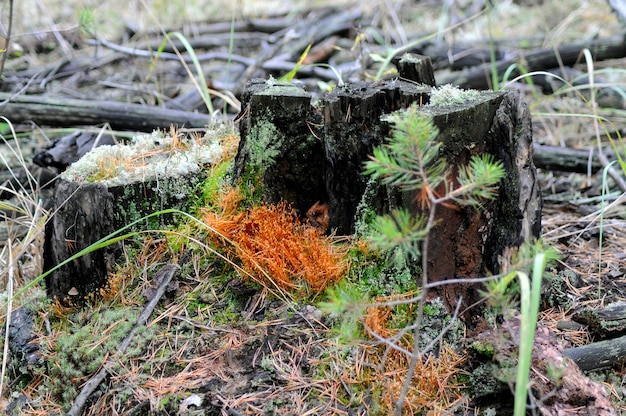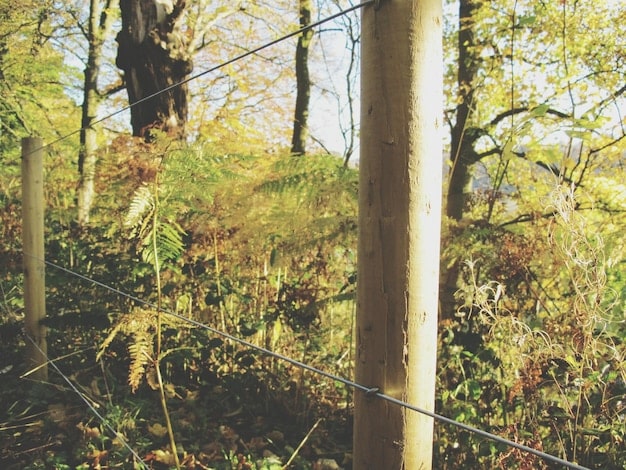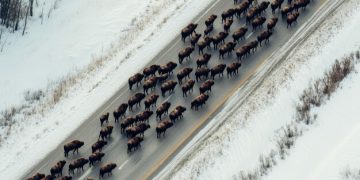Managing Deer Populations: Strategies for Protecting US Native Plants

Managing deer populations in the US is crucial for reducing overgrazing and protecting native plant species through strategies like regulated hunting, habitat modification, and deer exclusion methods.
The unchecked expansion of deer populations across the United States poses a significant threat to the health of local ecosystems. Managing deer populations: strategies for reducing overgrazing and protecting native plants in the US requires a multi-faceted approach to mitigate their impact.
Understanding Deer Overpopulation and Its Impact
Deer overpopulation occurs when the number of deer in a given area exceeds the carrying capacity of the environment. This imbalance leads to overgrazing, habitat degradation, and a decline in native plant biodiversity. Understanding the causes and consequences of this issue is the first step towards effective deer population management.
Causes of Deer Overpopulation
Several factors contribute to the increase in deer populations, including:
- Loss of Natural Predators: The decline of predators such as wolves and mountain lions has allowed deer populations to grow unchecked.
- Habitat Fragmentation: The conversion of forests and natural areas into residential and agricultural land has created ideal edge habitats for deer, favoring their proliferation.
- Supplemental Feeding: Intentional or unintentional feeding of deer by humans provides them with an easily accessible food source, further boosting their numbers.
These factors, combined with the deer’s ability to adapt to various environments, have created a situation where deer populations are out of control in many areas of the US.
Impact on Native Plants and Ecosystems
The consequences of deer overpopulation are far-reaching and can have devastating effects on native plant communities and overall ecosystem health. Native plants often lack the defenses to withstand heavy grazing pressure from deer.
Overgrazing by deer can eliminate sensitive plant species, alter forest regeneration, reduce habitat for other wildlife, and increase soil erosion. These effects ripple through the entire ecosystem, affecting everything from insects to birds.

In conclusion, the causes of deer overpopulation are complex, involving ecological and human factors. The impact on native plants and ecosystems is significant, highlighting the need for effective management strategies.
Regulated Hunting: A Traditional Management Tool
Regulated hunting is one of the most traditional and widely used methods for managing deer populations. It involves establishing hunting seasons and regulations to control the number of deer harvested each year. When implemented effectively, regulated hunting can help maintain deer populations at sustainable levels, reducing their impact on native plants.
Benefits of Regulated Hunting
Regulated hunting offers numerous benefits, including:
- Population Control: Hunting helps to keep deer populations in check, preventing overgrazing and habitat degradation.
- Economic Benefits: Hunting generates revenue through license sales and tourism, contributing to local economies.
- Recreational Opportunities: Hunting provides recreational opportunities for outdoor enthusiasts and promotes wildlife conservation.
However, the success of regulated hunting depends on careful planning and monitoring to ensure that it is effective in achieving its management goals.
Challenges and Considerations
There are several challenges associated with regulated hunting, such as:
Public Acceptance: Some individuals and groups may oppose hunting for ethical or animal welfare reasons.
Accessibility: Access to hunting lands may be limited, particularly in urban and suburban areas.
Effectiveness: Hunting may not be effective in reducing deer populations in areas where hunting pressure is low or where deer are concentrated in small areas.
Careful consideration must be given to these challenges and considerations when designing and implementing regulated hunting programs to manage deer populations effectively.
Regulated hunting is a traditional management tool with a lot of benefits. Addressing some challenges ensures its effectiveness.
Habitat Modification: Enhancing Native Plant Resilience
Habitat modification involves altering the environment to make it less suitable for deer or more favorable for native plants. This can include measures such as creating barriers to protect vulnerable plants or restoring degraded habitats. By manipulating the environment, land managers can reduce the impact of deer overgrazing and promote the recovery of native plant communities.

Creating Barriers to Protect Plants
Protecting vulnerable plants from deer browsing is a key component of habitat modification.
- Fencing: Installing fences around individual plants, groups of plants, or entire areas can prevent deer from accessing and grazing on them.
- Caging: Caging individual plants or small groups of plants can provide protection from deer browsing while allowing sunlight and air to reach the plants.
- Planting Deer-Resistant Species: Selecting and planting native plant species that are less palatable to deer can reduce grazing pressure on more desirable species.
Restoring Degraded Habitats
Restoring degraded habitats is essential for promoting the recovery of native plant communities.
Revegetation: Replanting native plant species in areas where they have been lost or reduced due to overgrazing can help restore biodiversity and ecosystem function.
Soil Enrichment: Improving soil health through the addition of organic matter or other amendments can enhance plant growth and resilience. Creating a sustainable environment.
Through habitat modification, land managers can create healthier and more resilient ecosystems that are better able to withstand the impacts of deer overgrazing. Protective barriers allow plants to flourish.
Deer Exclusion Methods: Fencing and Other Barriers
Deer exclusion methods are physical barriers designed to prevent deer from accessing specific areas. Fencing is the most common and widely used deer exclusion method, but other barriers such as netting and tree tubes can also be effective in certain situations. Exclusion methods can protect gardens and local plant life.
Types of Fencing
There are several types of fencing available for excluding deer, each with its own advantages and disadvantages.
Woven Wire Fences: Woven wire fences are durable and effective at excluding deer, but they can be expensive and difficult to install.
Electric Fences: Electric fences are less expensive than woven wire fences, but they require regular maintenance to ensure that they are functioning properly.
Plastic Netting Fences: Plastic netting fences are lightweight and easy to install, but they are less durable than other types of fencing.
The choice of fencing material depends on factors such as cost, durability, and ease of installation.
Alternative Barriers
In addition to fencing, there are other barriers that can be used to exclude deer from specific areas.
- Netting: Netting can be used to protect individual plants or small groups of plants from deer browsing.
- Tree Tubes: Tree tubes are plastic cylinders that are placed around young trees to protect them from deer browsing.
These alternative barriers can be effective in certain situations, but they may not be practical for protecting large areas.
Choosing the right exclusion methods for a given situation requires careful consideration of site-specific factors such as deer pressure, cost, and maintenance requirements.
Non-Lethal Deterrents: Repellents and Scare Tactics
Non-lethal deterrents are methods that discourage deer from entering an area without harming or killing them. These deterrents can include repellents, scare tactics, and other techniques that make the environment less attractive to deer. Non-lethal deterrents offer a humane alternative to traditional management methods like hunting, providing temporary relief from deer browsing.
Types of Repellents
Repellents are substances that are sprayed or applied to plants to make them less palatable to deer.
Contact Repellents: Contact repellents are applied directly to plant foliage and deter deer by making the plants taste bad.
Area Repellents: Area repellents are placed around plants or in the environment and deter deer through odor or other sensory cues.
The effectiveness of repellents can vary depending on factors such as deer pressure, weather conditions, and the type of repellent used.
Scare Tactics
Scare tactics involve using visual or auditory stimuli to frighten deer away from an area.
- Motion-Activated Devices: Motion-activated sprinklers or noisemakers can startle deer and discourage them from entering an area.
- Visual Deterrents: Flashing lights, scarecrows, or reflective tape can create a visual deterrent that frightens deer away.
These tactics keep deer from causing trouble.
Non-lethal deterrents can provide a temporary solution to deer browsing problems, but they need to be used to ensure effectiveness.
Community Involvement and Education
Community involvement and education are essential for the success of any deer management program. Engaging local residents, landowners, and other stakeholders in the decision-making process can help build public support for management efforts and ensure that they are sustainable over the long term. Education plays a crucial role in raising awareness.
Public Education Campaigns
Educated communities can help in resolving issues related to wildlife.
- Workshops and Seminars: Offering workshops and seminars on deer behavior, habitat management, and non-lethal deterrents can provide residents with the knowledge and tools they need to address deer browsing problems.
- Informational Materials: Distributing brochures, fact sheets, and other informational materials can raise awareness about deer management issues and promote responsible behavior.
- Community Forums: Holding community forums or meetings can provide a platform for discussion and collaboration on deer management issues.
Collaborative Partnerships
Collaborative partnerships between government agencies, non-profit organizations, and community groups can help to coordinate deer management efforts and leverage resources.
Landowner Agreements: Establishing agreements with landowners to manage deer populations on their properties can help to expand the scope of management efforts and improve their effectiveness.
Working groups will help the deer thrive.
By fostering a sense of shared responsibility and promoting informed decision-making, community involvement and education can lead to more effective and sustainable deer management outcomes.
| Key Point | Brief Description |
|---|---|
| 🦌 Overpopulation | Deer overpopulation significantly impacts native plants and ecosystems. |
| 🏹 Hunting | Regulated hunting helps control deer populations, offering recreational and economic benefits. |
| 🌿 Habitat | Habitat modification enhances native plant resilience and protects vulnerable species. |
| 🚧 Exclusion | Deer exclusion methods, like fencing, prevent deer from accessing specific areas. |
FAQ
▼
Managing deer populations is essential to prevent overgrazing, protect native plant species, and maintain overall ecosystem health. Uncontrolled deer populations can lead to habitat degradation.
▼
Common strategies include regulated hunting, habitat modification, deer exclusion methods like fencing, and non-lethal deterrents such as repellents and scare tactics to manage their browsing habits.
▼
Regulated hunting helps control deer populations by establishing specific hunting seasons and regulations, allowing for a controlled harvest that keeps deer numbers at a sustainable level.
▼
Habitat modification techniques include creating barriers to protect plants, restoring degraded habitats, and planting deer-resistant species to make the environment less attractive to deer. This ensures biodiversity.
▼
Community involvement and education are crucial for building public support and ensuring the long-term sustainability of deer management programs. This is achieveable through collaborative partnerships.
Conclusion
Effectively managing deer populations is a complex but essential task for maintaining healthy ecosystems and protecting native plant species in the US. By implementing a combination of strategies such as regulated hunting, habitat modification, and community involvement, we can achieve a balance that benefits both wildlife and people.





